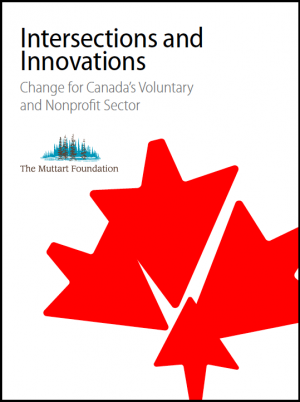Excerpt from chapter 3 of the book “Intersections and Innovations: Change for Canada’s Voluntary and Nonprofit Sector,” which is edited by Susan Phillips and Bob Wyatt and published as a free e-book by the Muttart Foundation.
Chapter 3: Four Keys to Make Sense of Traditions in the Nonprofit Sector in Canada: Historical Contexts
By Dominique Marshall
In a feudal order, based on hereditary land ownership, society was divided into stable ranks. One’s immutable place was either among the rich or among the poor and was associated with duties toward the welfare of all. Giving to the Church could ease one’s salvation, and receiving alms was an entitlement of the poor. The French feudal system of land allocation and occupation of central Canada, from 1624 to 1850, regulated the lives of tenants, who represented more than three-quarters of the population of what is now Quebec. There existed no public system of poor relief, but, in exchange for their censitaires’ work and money, the seigneurs owed them protection, the provision of sufficient land to sustain their family, mills, commons, courts of law, and hunting and fishing rights. In such a social order of uneven and reciprocal relations, giving to the poor was the justification of the upper-class privileges (Robinson, 2019; O’Leary McNeice, 2020). So, too, was maintaining churches and the array of social functions churches performed, including education, welfare, and the promotion of the arts. Having said this, the North American labour market presented more economic opportunities than in many parts of the Old World, and feudalism left a lesser mark on philanthropy than in closed societies (Dechêne, 1992).
 Originating from late medieval times, Britain’s Poor Laws never made it to the statutes of its Canadian colonies. But many of the Poor Laws’ principles and institutions played a formative role in the history of the voluntary sector in the country, including means tests, categories of poverty (deserving, non-deserving, dependent, or abled-bodied), vagrancy laws, poor rates, workhouses, and poorhouses. Until 1349, a voluntary system of relief of the poor had prevailed, which was under the responsibility of the clergy and funded by charitable giving and other Church income. When plagues, famines, and primitive industrial transformation tested the limits of this nonprofit sector, English monarchs inaugurated a public system of poor relief: they instructed local governments within each Church district to take responsibility for the vagrants and beggars of their territory. Obligatory taxes, levied and spent by local governments, guaranteed a supply of money for the relief of the indigent, as well as the subsistence of the working poor. In this way, the feudal system of serfdom was adjusted to keep agricultural workers in their locality to toil the soil of the landowning nobility and prevent social unrest. The Poor Laws heavily restricted the right to assistance by tying relief to one’s proof of continuous residency in a district; limiting begging licences to people who local authorities determined to be too ill, old, or disabled to work; punishing or imprisoning poor people deemed able to work, or those who were found away from their parish; and contributing to the maintenance of wages under the levels of subsistence. The Poor Laws of the late Middle Ages survived two overhauls, in the 16th century and the early 19th century. Their implementation required the construction of a growing network of local and public institutions for the “deserving” poor, where conditions were most often wanting, and which would serve as models for European charities and governments of Canada…
Originating from late medieval times, Britain’s Poor Laws never made it to the statutes of its Canadian colonies. But many of the Poor Laws’ principles and institutions played a formative role in the history of the voluntary sector in the country, including means tests, categories of poverty (deserving, non-deserving, dependent, or abled-bodied), vagrancy laws, poor rates, workhouses, and poorhouses. Until 1349, a voluntary system of relief of the poor had prevailed, which was under the responsibility of the clergy and funded by charitable giving and other Church income. When plagues, famines, and primitive industrial transformation tested the limits of this nonprofit sector, English monarchs inaugurated a public system of poor relief: they instructed local governments within each Church district to take responsibility for the vagrants and beggars of their territory. Obligatory taxes, levied and spent by local governments, guaranteed a supply of money for the relief of the indigent, as well as the subsistence of the working poor. In this way, the feudal system of serfdom was adjusted to keep agricultural workers in their locality to toil the soil of the landowning nobility and prevent social unrest. The Poor Laws heavily restricted the right to assistance by tying relief to one’s proof of continuous residency in a district; limiting begging licences to people who local authorities determined to be too ill, old, or disabled to work; punishing or imprisoning poor people deemed able to work, or those who were found away from their parish; and contributing to the maintenance of wages under the levels of subsistence. The Poor Laws of the late Middle Ages survived two overhauls, in the 16th century and the early 19th century. Their implementation required the construction of a growing network of local and public institutions for the “deserving” poor, where conditions were most often wanting, and which would serve as models for European charities and governments of Canada…
Click here for access to a pdf of Chapter 3, “Four Keys to Make Sense of Traditions in the Nonprofit Sector in Canada: Historical Contexts” (including sources), by Dominique Marshall, as well as access to other chapters.
Dominique Marshall is a Professor in the Department of History at Carleton University. She teaches and researches the past of social policy, children’s rights, humanitarian aid, refugees, disability and technology. Join Marshall on Twitter.
Sunday, September 26, 2021 in Intersections & Innovations
Share: Twitter, Facebook



